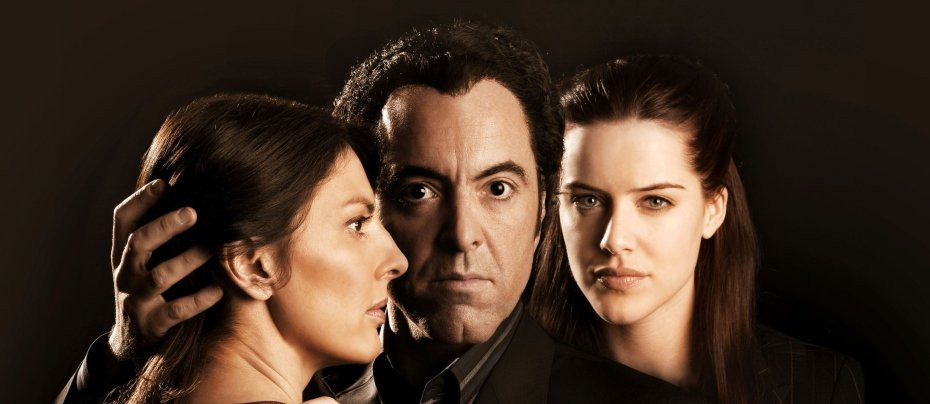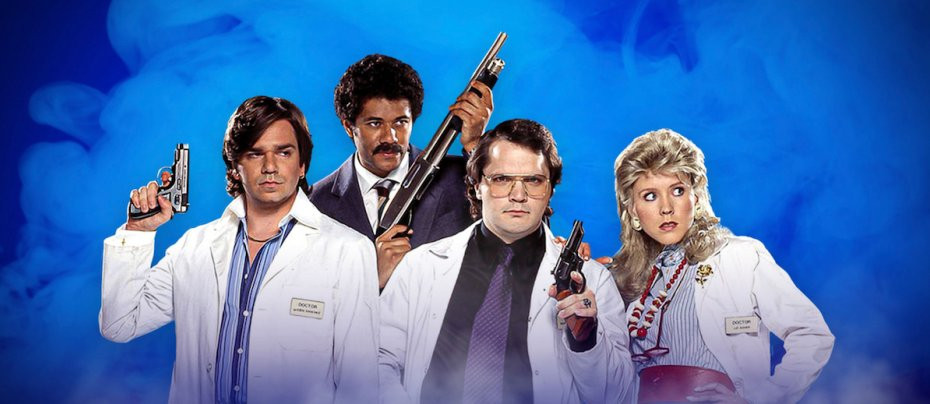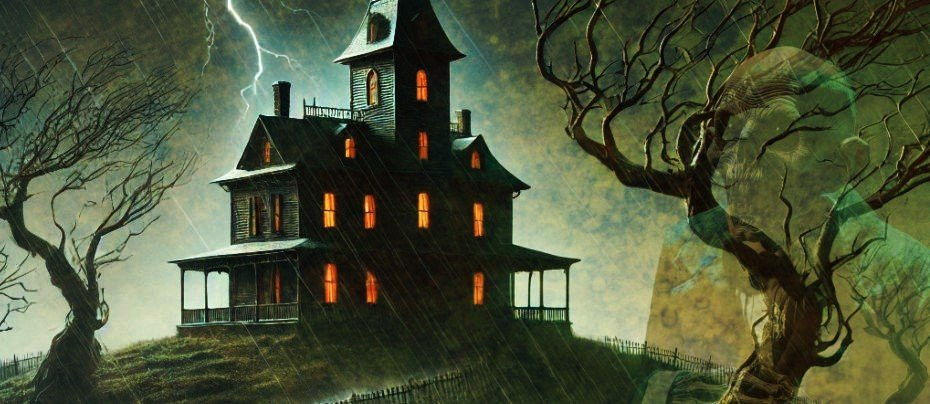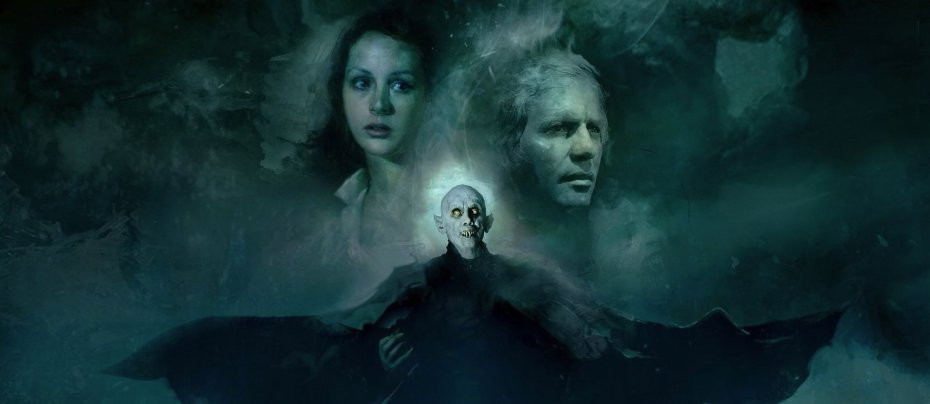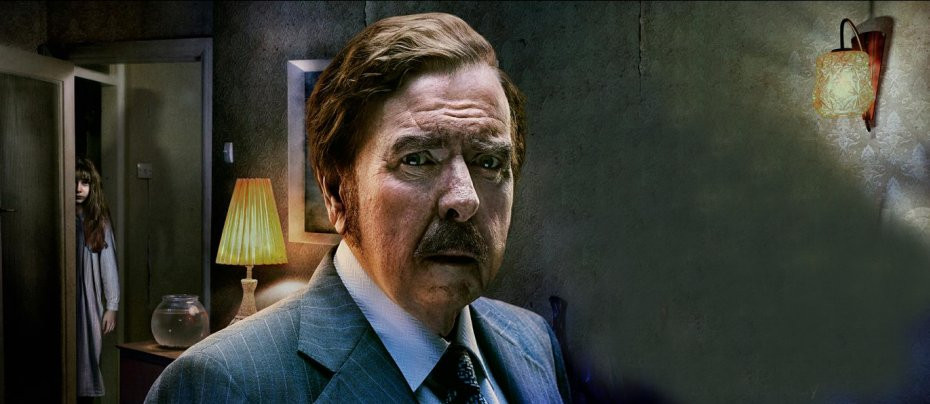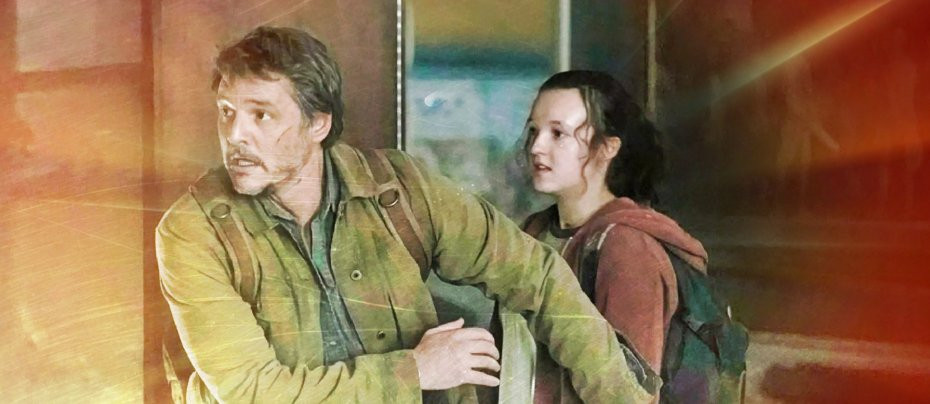
Hammer House of Horror - Episode by Creepy Episode
Hammer House of Horror was a thirteen-part series first shown on ITV in the latter part of 1980. Produced by Roy Skeggs it was Hammer's attempt to break into the TV market. It has been rarely shown on TV since but, while there are few genuine moments of horror contained within it, it still has the power to shock.
Andrew Coby takes us through each episode
Hammer House of Horror is not to be confused with Homes Under the Hammer although, and I am well aware that I am writing this out of pure envy, I would like to see some of the prospective property tycoons in the latter on the receiving end of a good haunting. Most of the episodes leave the viewer feeling mildly uneasy and this isn't a bad thing but, as a title, the producer probably thought that the Hammer House of Mild Unease lacked pulling power. The series provided good entertainment with decent, if sometimes impenetrable, plots and some reliable acting. The production values were good, the scenery was attractive and it had a killer theme tune. I have given my impressions of this series below. All episodes are included but, as Eric Morecambe might have said, they are not necessarily in the right order.

It is strange that way the memory plays tricks on you. I had completely forgotten that Denholm Elliott starred in Rude Awakening, the one about the estate agent who may or may not have been having an affair with his secretary and may or may not have been the victim of a plot to send him mad. Rude Awakening is a tale that lacks the courage of its convictions because it is not made clear at the end what it is all about. It concerns Norman Shenley, an estate agent, played with his usual seedy charm by Denholm Elliott, who dreams regular dreams of murdering his wife because she won't give him a divorce. An honourable mention must go to Pat Heywood who is superb as his wife. He has a secretary, the enticingly named Lolly, about whom he understandably has regular fantasies. Lolly is a game girl. Played by Lucy Gutteridge, who was last seen in Top Secret, a sub Police Squad comedy with Val Kilmer in the early 1980s, she appears in various seductive garbs such as a sexy punk outfit with leather mini skirt and a school girl complete with knee socks. She also appears dressed in a raincoat that she takes off to engage in a bout of naked grappling in a phone box. The plot is made more murky by phone calls requesting Mr Shenley to visit a recently vacated manor house, Lower Manor Court, and mysterious voices telling him he shouldn't have killed his wife. In the end he murders his wife in expectation of running off with the lovely Lolly but instead is carted off by the police, his relationship with his secretary being purely wishful thinking. The vagueness of the plot should not detract from some great set pieces. The scenes in which Shenley visits the manor house only for his wife's dead body to fall out of the dumb waiter and, later, to be told by its owner that she is dead, as is he, are very creepy indeed. The owner of the manor house is played by Eleanor Summerfield, indubitably, veraciously, incontrovertibly the wife of Leonard Sachs, that bloke who played the loquacious Master of Ceremonies in The Good Old Days. Another good scene is when Shenley and Lolly visit a block of flats, only for it to be in the process of being demolished by a wrecking ball. The incongruous words 'Rumpy Pumpy' can be seen scrawled on a wall in the flats, which must be the most refined piece of graffiti ever seen in a tower block. Kiwi actor James Laurenson enjoys himself immensely three times over as the mysterious Mr Rayburn, the caretaker and the policeman who arrests Shenley at the end.
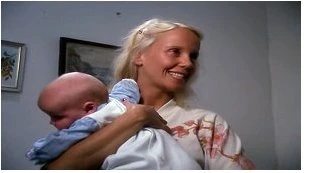
The Hammer House returns to the theme of reality versus unreality in The Mark of Satan but whereas Rude Awakening goes for the light-hearted, almost camp, approach, The Mark of Satan approaches its theme with menace and a real sense of doom. It is helped by a marvellously intense performance from Peter McEnery, moustache and all, as Edwin. He doesn't appear to have much of a life, living at home with his elderly and overbearing mother and their lodger and her baby. Incidentally, the effect that parents have on their kids is a subject that is addressed more than once in this series, particularly in Growing Pains and The House that Bled to Death. Edwin works as a hospital anaesthetist who, after a man dies on the operating table, is moved to the morgue. Here he works with a pathologically cheerful pathologist, played by Emrys Williams, and begins to develop an obsession with the number 9. Edwin also thinks that the police are trying to contact him on his car radio via a weathervane opposite the spot where he parks his car. It would be scary enough if this was a depiction of a descent into madness but the viewer is never quite sure what is going on. Edwin is hospitalised because of his increasing paranoia and there are scenes in which the pathologist and Edwin's immediate superior appear to form part of a coven with Edwin's lodger, complete with sacrificial baby, and the mysterious Dr Manders to gain control of his mind. In these scenes the episode skilfully conveys a sense of dislocation and uncertainty. Edwin is in hospital, presumably to be looked after by professionals with his best interests at heart but, then again, he may have been hospitalised so that the same people can take control of him. The only time these scenes descend into parody is when a comedy vicar interrupts the coven with a cross made from two white posts. Edwin's lodger is played by the entertainingly eccentric Georgina Hale as a sinister gold digger. Her performance is ramped down a couple of notches from the one she gave in the Beerhunter episode of Minder but there a couple of moments when she threatens to go completely over the top. It is good work by the director to reign her in methinks but, to give Miss Georgina her due, no one can make the words 'I'll make us a nice cup of tea' sound so threatening. No doubt with her eye on the rambling property in which she lodges, she helps Edwin hide his mother's body in the freezer when he stabs her to death. The scene in which he stabs his mother, casually sticking in the knife and giving it a few twists, is played without melodrama and is all the more powerful for it. The impressive aspect of this episode is that the viewer has no idea how it will end. The final haunting scene, in which a wide awake Edwin has his skull drilled into on the operating table takes the viewer all the way back to the start. It's a disturbing ending to a disturbing episode.
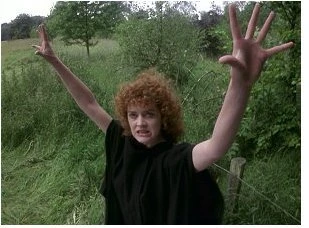
Witching Time stars the estimable, and sadly under-used in TV land, Jon Finch and co-stars Prunella Gee and Patricia Quinn. Finch plays David Winter, a depressed, workaholic composer who locks himself away in his cottage convinced that his wife, Mary, played by the ever lovely Prunella Gee, is having an affair with their GP. He is right, too. She was having an affair with the GP but she has ditched him for failing to commit. Quinn plays Lucinda Jessop, a witch who returns from the 17th century to try to ensnare David for her own. With a curly perm borrowed from little Leo Sayer and dressed in a black cloak she looks like a free and easy version of the woman from the Scottish Widows advert. After a night of passion with David she attempts to do away with his wife by making her fall from her horse and then by sticking pins into her wax effigy. The scene in which Mary painfully pulls the needles out of the effigy so that she can walk straight again is well done and I don't recall seeing such a scene before or since. Lucinda also has a handy, 17th century, way with words, scrawling the memorable graffiti 'Strumpet Whore' across one of the walls of the cottage. At least this is an improvement on the rather middle-class 'Rumpy Pumpy' which appears in Rude Awakening. This episode is not the least bit unsettling but it is quite entertaining. In the end, after a struggle with David, Lucinda is drowned in a horse trough by Mary and her wax effigy thrown onto the fire that David has started with every intention of burning his wife at the stake. He is a fickle one, that David. The scene in which he hugs himself with delight as the flames take hold is, in my opinion, the highlight of the whole episode. Husband and wife are reconciled at the end, in the only example of a relatively happy ending in the Hammer House. The episode is also notable for a pre-grandad-from-Only-Fools-and-Horses appearance from a very well-spoken Lennard Pearce as a priest who mutters some mumbo jumbo about exorcism.
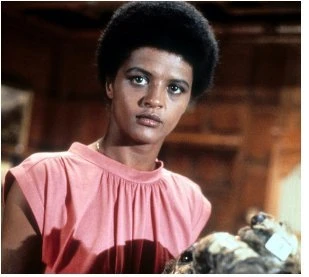
Voodoo also puts in an appearance in Charlie Boy. The eponymous item is a wooden African head, or fetish, which comes into the possession of Graham Elder, played by a former Mr Twiggy, Leigh Lawson. There are no real scares in this but the wooden head is decidedly ugly. There are some unusual deaths, though - the original owner of the head falls from his roof while trying to adjust a TV aerial, Michael Culver, playing the brother, jumps a fence on horseback only to fall from the horse and become impaled on the blades of a plough, a film director, played by Michael Deeks, is killed directing an advert when a faulty crossbow shoots an arrow into his chest. This is the first thing I have seen Deeks in since his victorious turn as Swiftnick in the Richard O'Sullivan vehicle The Adventures of Dick Turpin. It's a shame he has been used so sparingly in TV land as he always had a cheery, likeable presence.
The hero's girlfriend, Sarah, is played by Angela Bruce, remembered by this viewer as home wrecker Janice Stubbs, Ray Langton's bit on the side who lured him from the lovely Deirdre in Coronation Street. Around about the same time as she was appearing in the Street, ITV showed the film version of Man at the Top, in which she played a hitch hiking conquest of Joe Lampton. In a memorable scene she popped up starkers in the shower, forming one third of a soap filled threesome with Kenneth Haigh and Margaret Heald. But back to the plot, Lawson realises that these deaths are a result of his recent possession of Charlie Boy and decides that it must be destroyed. Unfortunately for him it is stolen, right from under his nose. There is a good cameo here from Jeff Rawle as the uninterested policeman who probably thinks he has better things to do with his time than chase after wooden heads. Lawson finds out via expert Marius Goring that it was taken by a dodgy dealer named Peter Picardo, played with aplomb by everyone's favourite UK-based American, David Healey. Or possibly joint favourite UK-based American as I would hate to disappoint fans of the great Ed Bishop. He gets the fetish back and tries to burn it, but not before his girlfriend is killed in a car crash, thrown through the windscreen of her Mini. While trying to burn the fetish, he falls, knocks himself unconscious and perishes as the flames take hold.
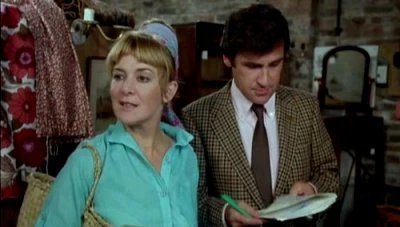
Guardian of the Abyss is probably the weakest of the series. The plot isn't very original and concerns a sect trying to find a suitable sacrifice to resurrect Choronzon which, when it's not almost being a spicy Spanish sausage, is the eponymous guardian. The great disadvantage is that the story is saddled with the lightweight Ray Lonnen and Rosalyn Landor in an attempt to engage the viewer. Admittedly, Paul Darrow and John Carson put in good shifts as members of the sect but Lonnen and Landor, while undeniably handsome, have very little chemistry or screen presence. Lonnen plays Michael, an antiques dealer who comes across a scrying glass which, apparently, is essential if you wish to summon up Choronzon. Darrow takes a shine to this but, in a not very believable plot device because everyone knows from Dickinson's Real Deal and Antiques Roadtrip that antique dealers are money grabbers out to make a quick profit, is unable to gain possession of it, regardless of the money he offers. While driving home, Michael is stopped by Allison, played by Landor, who tells him that she is being chased by a bunch of Satanists. If it had been me, I would have said sorry full up but Michael lets her in and takes her home. Voodoo makes yet another appearance in the Hammer House in a ridiculous scene in which our hero and heroine are bewitched into bed by way of two wax dolls playing doctors and nurses. Who would have thought that the Landor character would have worn belly-warmers ? Not I, for one. The final scenes are well handled though. Lonnen is strapped to the altar and has his heart pierced with a dagger, metamorphoses into a bull-like creature and then returns back to life as Ray Lonnen, Choronzon incarnate, with Landor as his right hand woman. Overall, this is a very weak episode, fatally compromised by Lonnen and Landor. If I was a devil worshipper I would strongly object to the implication that I could be bewitched by such a lacklustre pair. They couldn't be trusted to guard a hole in the road never mind the gateway to everlasting damnation. To sum up, if Satanist thrills are what you're after, watch The Devil Rides Out. It's much more fun.
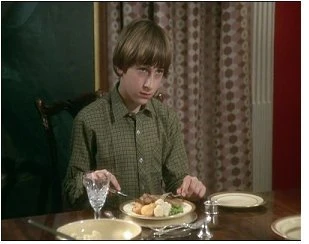
There isn't a voodoo doll in sight in Growing Pains and that is no bad thing. The story concerns a high powered, outwardly altruistic couple, Laurie and Terence Morton, one of whom attends very important meetings in London while the other, the father, is working on eradicating world hunger with the aid of some white powder and a shedful of white rabbits. The couple have a son who both neglect in favour of their work saving others. The mother is played by Barbara Kellerman who I must confess I don't recognise from anything else I have witnessed in TV land. The father is played by Gary Bond, the paper hanger in Zulu who, despite the meticulous ministrations of Surgeon-Major Reynolds, soon becomes a dead paper hanger. Their ten-year-old son, William, is neglected by his parents, eats some of his dad's white powder and dies painfully. Not to be deterred by the death of one son, the couple adopt another, James. On the way home from the adoption, Laurie's car goes out of control and both her and her new son narrowly avoid death. Things get worse. At home, the family's normally reliable dog, Nipper, goes berserk, bites Terence and kills the rabbits. The family meal becomes maggot infested and the dead son's grave becomes disturbed. James finds a poem written by his predecessor in which he writes that his parents are so concerned with helping others that they view him only as a 'distant comet'. These are sad, not to say astute, words to come from the pen of a ten-year-old. Terence dies, lured to his death by the spirit of his dead son and then everything turns out fine. Mother and adopted son walk off into the sunset. This is a good episode whose moral seems to be that you should not neglect your kids, particularly if you're the father. Why Laurie should have got off so lightly is not explained. It also benefits from a good cameo from the great and much missed Norman Beaton as an African delegate who visits the Mortons' house to discuss world hunger. The part of James is well played by Matthew Blakstad. He reminds me of a more sinister version of 1970s child actor Gary Warren. Whatever happened to him?
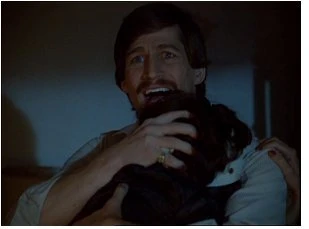
Visitor from the Grave is an average episode, saved by a decent twist at the end. For the only time in the series, the producers decided to cast an American leading lady for this one. The bland Kathryn Leigh Scott plays Penny, a mentally disturbed heiress who is looked after by her caring husband Harry, played by Simon McCorkindale. I don't know why an American actress was chosen. Surely the lovely Susans George and Penhaligon wouldn't have been doing much at the time and they have a decent track record of playing damsels in distress. Having said this, it is debatable whether Susan Penhaligon would have recovered from the traumas inflicted on her in Bouquet of Barbed Wire and Another Bouquet by the time the Hammer House came around. Never mind, Kathryn Leigh Scott it is.
One night a stranger breaks into the cottage and attempts to rape Penny. Rape is a terrible thing and is always a delicate subject to introduce into a drama but this is a powerful scene. Stanley Lebor, who plays the attacker, is well-built and menacing but Penny manages to fight him off and shoot him with a shotgun. What a marvellous actor Lebor is. Who'd have thought he would have gone on to play Howard, the slightly less feminine half of the Howard and Hilda combo in Ever Decreasing Circles? Penny's husband, Harry, turns up at the cottage shortly afterwards and, instead of calling the police, buries the body and tells Penny to tidy the place up. He tells Penny that he recognises the body as that of Daley, a work associate of his and explains that he doesn't want the police involved because he doesn't want her to be locked up again. Their life continues as normal but Penny has visions of Daley which cause her to question her mental well-being. Her husband is outwardly caring but as he is played by Simon McCorkindale, for God's sake, the viewer knows that it is all a sham. There then follows fifty-odd minutes of deceit by Harry, in league with Daley (who isn't dead after all), a fake medium called Margaret and that bloke from Blake's 7, Gareth Thomas, who doubles up as a pretend policeman and an Indian holy man. The plan is to drive Penny so mad that she kills herself and Harry can claim her fortune. The plan works and Penny shoots herself with the same shotgun that she used to shoot Daley. This leads to much merriment within the gang of four who celebrate with champagne and bundles of cash at the cottage. Cue the sound of a cold wind and the ghostly sight of Penny drifting through the French windows and out for vengeance. The bundles of cash burst into flames and the viewer knows that, from now on, the deceitful four will never rest easy in their beds. This episode has a really powerful beginning and an unexpected ending so it's a shame that the middle section should be so lacking in originality or suspense.
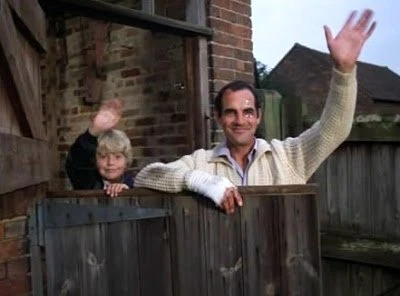
The Two Faces of Evil is, in my opinion, the most stylish episode of the series. While the story is not particularly original, the performances and the sets make it stand out. It beings innocently enough as Paul, Janet and their young son David are driving merrily along in their nice red car. A stranger appears out of nowhere and the car skids to avoid him. The stranger is wearing yellow oilskins, which should have set alarm bells ringing straight away but the father ignores his wife's advice and picks up the stranger. His wife is correct in her suspicions. I mean, no one trustworthy has worn oilskins since about 1880. The stranger attacks her husband who loses control of the car and the car overturns. The next scene is in a hospital ward. The wife, played by Anna Calder-Marshall has been only slightly injured but her husband, played by Gary Raymond, is in intensive care. Curiously, their young son David, played by Paul Hawkins, is unscathed.
Some thought has clearly gone into the set design. The hospital scenes are very creepy and are reminiscent of those in The Mark of Satan. The wards have clinical white walls, the corridors are white with black and white flooring. Everything is a combination of black, white and grey, even David's clothing. There is the occasional splash of red in the hospital blankets and the red shirt beneath David's jumper and, of course, the red car in Janet's flashbacks of the crash. One of the most disturbing aspects of this episode is that the doctors and nurses appear to be uncaring. Even the policeman, played with his usual menace by Mike Savage, appears untrustworthy and unhelpful when questioning Janet about what happened. Eventually, her husband is allowed home to recover. In fact, it isn't her husband but his doppelganger and Janet only realises this when she sees his rotten teeth. Janet and David are then chased through the countryside by the doppelganger to the tune of Yakkety Sax, the well-known theme from Benny Hill. I made up the last part of that sentence but you should play the scene while listening to this tune. It really works. Hiding in a barn, Janet sees her son's dead body as he is turned into a snarling replicant, rotten teeth and all. In the end, Janet is put into a waiting ambulance which is driven by herself. So the real Janet will go the way of her husband and son and be killed to make way for her replicant. Food for thought, indeed.
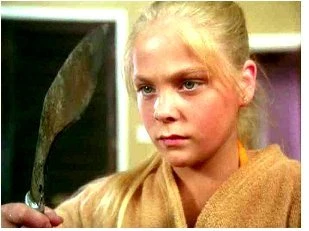
The House that Bled to Death is sub Amityville Horror hokum, as Leslie Halliwell would have put it. In a pleasing, wordless start, an old man, played by George Tovey, puts some poison in a cup of cocoa that he has just made for his wife. She drinks it and shortly afterwards collapses. Her husband then takes a kukri knife from the wall and, well, it isn't shown but we all know what he does next. It is always good to see even a wordless George Tovey but, after this promising start, it's downhill all the way. The house is bought by William Peters, his partner and her daughter. There is an appearance here from the lugubrious Milton Johns, who the viewer assumes is an estate agent. Mr Peters and partner are unconvincingly played by Nicholas Ball and Rachel Davies. Much better value are lovable cockney Brian Croucher, driving a cherishable blue Austin Maxi, and Patricia Maynard, ex-wife of Dennis Waterman, as the couple's mildly voyeuristic neighbours who, knowing all about what happened in their new neighbours' house behind closed curtains, can't resist making friendly overtures so that they can have an ogle inside the house of death. Slowly but surely, the house is redecorated and becomes a sort of home. I don't think I could let this pass without a comment that, in the course of the renovations, Mr Peters makes the classic DIY faux pas of painting the window frames without opening the windows. I was shouting at the screen 'You'll never be able to open those windows again, mate' but, separated by a glass screen and thirty-odd years, my cries went unheard.
There follows spooky goings-on such as blood dripping down walls and the gas valve being turned on and off of its own accord. The daughter's cat is also found in a bloody heap on the window sill having tried unsuccessfully to enter the house via a broken window. The daughter doesn't have much luck because her birthday party is marred by an unwelcome gift of a kukri knife and then by the water pipe bursting open and showering the kids at the party in blood.
The plot quickly gets bored with itself and it is revealed that Mr Peters and partner, in league with the Milton Johns character, who wasn't an estate agent after all but some sort of literary agent, had organised the whole sorry charade all along so that they could make money from a book and film about living in a blood soaked house. There is a massive plot hole here because I cannot see any way they could have made blood appear on the walls from nowhere or how the gas valve could move of its own accord. But no matter. Cut to three years later, Peters and family are living in California and the daughter, still traumatised by the death of her moggy and having to endure schoolyard taunts about her rubbish birthday party, learns that it has all been staged. Judging from the goose pimples on show in the swimming pool, it looks like cloudy Iver, Bucks doubled for the golden state for the day. The daughter takes the only course of action available in the circumstances and attacks them both with the kukri knife. If nothing else, this episode is a salutary reminder of the long lasting effects our actions can have on our kids. Any wrongdoing, however unintentional, can come back and bite a parent on the backside or, in the case of this greedy but unfortunate couple, hack them to death in not so sunny Californ-eye-ay.
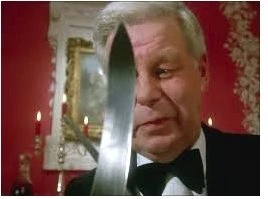
The Thirteenth Reunion is an original tale concerning a journalist Ruth, played by Julia Foster, who visits a sinister weight loss regime at a country house so that she can report back for her readers. She is sent on this perilous mission by her editor, played by Dinah Sheridan, still as attractive in her late fifties as she was in Genevieve. Why a journalist played by the stick thin Julia Foster would need to visit a weight loss retreat is never addressed.
At the retreat Ruth meets Mr Willis, a PE teacher cum sergeant major played by the laudable James Cosmo. The scene in which Cosmo removes any sense of self-worth from an overweight woman is truly chilling. She then meets Ben, played by Warren Clarke, who is a sensitive banker desperate to lose weight and who dies in a mysterious car crash. Ruth then meets an undertaker's assistant who tells her about shady goings on after hours in the funeral parlour. The undertakers, Mr Basil and Mr Cedric are played by Norman Bird and George Innes and they are in on a plot to kill residents at the weight loss retreat and supply the bodies to Sir Humphrey Chesterton, played by renowned grandfather type Richard Pearson.
Ruth discovers that the bodies are being provided for a monthly reunion of the survivors of a plane crash who survived by eating the corpses of the dead. Unfortunately for her, she is interrupted in her detective work by Mr Willis who, after explaining that he too was one of the survivors, kills her with a cleaver. This is a good and likeable episode but, as I have a long held fondness for Julia Foster ever since seeing her in Half a Sixpence, I was sorry to see her end up as part of the main course. Richard Pearson, playing against type, is very entertaining too but the biggest mystery in this episode is why the producers would hire Bird and Innes, cracking actors both, and then give them relatively little to do.
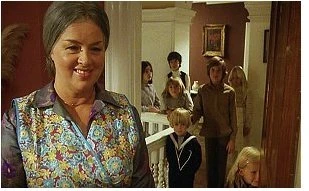
Children of the Full Moon gives the game away right from the start with its strong opening of an angelic looking young girl, with bloody mouth, gnawing away at the throat of an unfortunate lamb. Newly married couple Tom and Sarah Martin, played by Christopher Cazenove and Celia Gregory, set out on a belated honeymoon in the cottage lent to them by Tom's boss, played by Robert Urquhart. Tom is a high powered lawyer. The viewer knows he is high powered because he is seen jetting in from some exotic location and Sarah mutters dark things about Tom neglecting her. Somewhere in the wilds of deepest Buckinghamshire, Tom loses control of the car and manages to bring it to a halt by crashing into a verge, having thoughtfully advised Sarah to cross her arms over her face. With the car out of action, they make their way through some woods and end up at a house run by Mrs Ardoy. If they go down in the woods today, they're sure of a big surprise, the only question being which of the two is in for the bigger surprise. Mrs Ardoy is excellently played by Diana Dors. She manages to combine cheery good nature with threatening malevolence and this is not an easy thing to do. I tried it once and ended up thoroughly confused. Dors was a tremendous character actress and it's a shame this was not recognised more often. You should see her in Yield to the Night, The Amazing Mr Blunden or even Deep End if you have any doubts about that. Poor Robert Urquhart has to content himself with being the 'Guest Star' while Diana Dors wallows in the luxury of 'Special Guest Star' status. We're also promised an appearance from Bette Davis as 'Extra Special Guest Star But Only If You're Good'. We can't have been good because she failed to turn up, unless she was disguised as the werewolf that materialises at the Tom and Sarah's bedroom window. Children run freely about the house but Mrs Ardoy is unsure of how many she has. 'About eight' is the best estimate she can come up with. Tom decides to try and find his way back to the car and, while he is away, Sarah is taken to the bedroom where she is impregnated by a werewolf while Mrs Ardoy and the children listen attentively outside. It is like an adult fairy tale, think of a watered down version of Company of Wolves. After impregnation, Sarah and Tom are free to leave and continue their lives with Tom, not unreasonably, assuming the baby will be his. Sarah, having had a bit of wolf in her, develops a taste for steak, raw meat and passionate sex, much to the consternation of Tom. She is drawn back to the house in the woods, chomping on what looks like raw liver as she drives, gives birth at the house and dies shortly after. Tom, suspecting something is not quite right, also goes back to the house, getting as far as the woods where he meets the not so jolly woodman, Mr Ardoy, who kills him with his axe. Yet another couple in the Hammer House meet an untimely demise but it is an enjoyable episode. Werewolves always give good value for money and Diana Dors is terrific. I don't usually refer to directors but this episode was directed by Tom Clegg, which is also the name of the actor who played Oddbod in Carry on Screaming. Intensive enquiries by Inspector Google seem to show conclusively that they are not the same person but wouldn't it have been fun if they were?
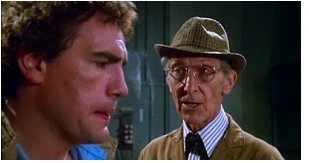
The Silent Scream is a marvellous episode but it has a depressing view of human nature. It's not a view to which I subscribe but, heck, it's only a TV programme so I'll let that pass. Failed safebreaker Chuck Spillers is newly released from prison and arrives back home, an improbably large cottage in the middle of an isolated field. Chuck is played by Brian Cox and when I say Brian Cox I mean the proper Brian Cox, not the ersatz one who flies around the universe with a face full of wonder. Chuck's wife Annie is played by the lovely Elaine Donnelly who was riding high at the time with her Saturday evening sitcom Lovely Couple. For all its faults as a sitcom it did have a memorable theme tune. After three, why the hullabaloo, if you love him and he loves you, do what all the lover-ly couples do. Like many in the Hammer House, Ms Donnelly has been woefully neglected by TV land in the intervening years. Chuck visits the pet shop of a man who visited him, and gave him money, while in prison. The man, Martin Blueck, is played by Peter Cushing who revels in his sinister role. After Chuck fails to return home, Annie goes to the police. As we're in the Hammer House the police couldn't care less so Annie is left to go after Chuck on her own. Chuck is trapped of course, unable to resist the safe in Mr Blueck's shop and falling through a strategically trapdoor when he attempts to open it. Mr Blueck, who reveals that he was a guard at a concentration camp, then uses him as an experiment in whether humans can be caged without the need for bars. Blueck's experiments are not that advanced, however, as they still required thousands of volts of electricity to ensure that Chuck, and later Annie, are kept ensnared.
The strong point about this is episode is the way it toys with the viewer's hopes that Chuck and Annie can survive. Annie goes to the police and at first Detective Sergeant Aldridge is uninterested. She returns later and leaves a message with the desk sergeant. Aldridge then appears to take an interest but is soon dissuaded by the desk sergeant. At the end, it is difficult not to share in Chuck and Annie's delight at escaping the clutches of Mr Blueck but this delight disappears on the realisation that they are trapped in their own home. In space no one can hear you scream but, as the ending of this episode proves, in a field in England no one can hear you scream either, and that's a much scarier message. Cushing is a good choice to play Mr Blueck as he is skilled at gradually revealing the nastiness that lurks underneath Blueck's character, and perhaps all of us.

The Carpathian Eagle is a straight up and down episode in which Suzanne Danielle plays Nathalie, a writer cum crazed psychopath who promises men sex and then reneges on the deal by ripping their hearts out. I must say, most of her victims deserve everything they get, especially the one who insists on being called Randy Andy. There are no surprises in this episode as the viewer knows from the start who the killer is. I don't think I'm letting cats out of any bags when I say that Danielle is not the most talented of actresses. I think the dual role of writer and killer is well beyond her and her Eastern European accent has to be heard to be disbelieved. In spite of Miss Danielle's acting I am happy to report that the rest of her is on Bafta-winning form. Sian Phillips pops up to flesh out the bones of the myth behind the Carpathian Eagle. As the descendant of an Eastern European Countess, she tells the tale of how the Countess has an affair with a falconer and arranges for her husband to be killed by an eagle who rips his heart out. She then has affairs with various young men, all of whom end up dying in the same gruesome way as her husband. What a great role this would have been for Ingrid Pitt.
Murderous Nathalie soon attracts the attention of Detective Inspector Clifford, played by Anthony Valentine. I always enjoy watching Valentine in action because he brings a smooth, unruffled approach to everything he does. He popped up unexpectedly at the end of Fun at St Fanny's, a comedy film from the 1950s starring Cardew Robinson and Fred Emney, and he hasn't changed a bit. His smooth approach is tested to the limit by his sergeant, played by Barry Stanton, who has a healthy disregard for Clifford's superior rank. One of the best bits of the whole episode is when the sergeant ends a radio conversation with Clifford with a flippant 'Roger dodge'. The viewer knows that he is going to be in trouble when he gets back to the station but does the good sergeant care? Not a jot he doesn't.
As the culprit is revealed right at the start, the script falls back on some psychobabble about multiple personalities to try to legitimise the whole farrago. Gary Waldhorn is the unfortunate actor called on to make it sound convincing. The equally unfortunate Detective Inspector Clifford meets a grisly end, mesmerised to the last by Suzanne Danielle's bottom. Danielle's bottom had a lot going for it in 1980 and, no doubt, still does. Nathalie continues her murderous ways, moving on to dressing up in a nurse's outfit to murder some unsuspecting hospital patients. For all its flimsiness, it's a highly watchable episode. Ms Danielle has rarely looked better, her Eastern European accent is worth a chuckle and you can't go wrong with Anthony Valentine. It's an episode that I would strongly recommend to fourteen-year-old boys everywhere.
OK, I have decided to do a rundown of the series, starting with the worst and building up to a climax with the worthiest, as follows:
No.13 - The Guardian of the Abyss. A portentous title, an unoriginal story and it's saddled with the two lightweight leads. When I think what someone like John Hallam and Cherie Lunghi would have done with the lead roles, I tut loudly.
No.12 - Visitor from the Grave. No surprises in this one as everyone knows that Simon McCorkindale only plays deceitful husbands. Loses marks for the casting of an American heroine, and a bland one at that, when plenty of home-grown actresses were available. Also, hard to believe that Hilda would allow Howard to be out so late at night.
No.11 - The House that Bled to Death. Pure corn from start to finish, redeemed only by the conniving pair getting their comeuppance. It would have moved a couple of places up the chart if the Milton Johns character had got what was coming to him as well.
No.10 - Growing Pains. While it was good to see the dog and the white rabbits bite the dust, why did the father bear the brunt of his dead son's unhappiness? Would have come in in 11th place were it not for an appearance from the wondrous Norman Beaton.
No.09 - Rude Awakening. Benefits from an edgy performance from Denholm Elliott and some entertaining dressing up from Lucy Gutteridge but is let down by its muddled ending. With a more convincing denouement it could have been a contender.
No.08 - Children of the Full Moon. Diana Dors is extremely entertaining and werewolves abound in a good, tongue in cheek but ultimately unadventurous episode. Christopher Cazenove and Celia Gregory lack lustre as the young couple but it's fun to watch Miss Gregory chomping away on handfuls of offal.
No.07 - Charlie Boy. Good, solid episode enlivened by the viewer's own memories of Angela Bruce's three-way frolics in the shower in Man at the Top. Inventive deaths and cheeky-faced Michael Deeks also help it attain a middling rating.
No.06 - The Thirteenth Reunion. An unusual premise and a shocking, unexpected ending that reinforces the blackness of its theme. The cast work hard, particularly James Cosmo, and it benefits from a cameo by Dinah Sheridan but it's a waste of good actors Norman Bird and George Innes.
No.05 - The Silent Scream. An unsettling and well-acted episode. Would have made it higher up the chart but, not his fault I know, Brian Cox shares his name with that scientist who, unbelievably, is probably more famous than the proper Brian Cox.
No.04 - The Two Faces of Evil. Stylish episode with stark interiors. Makes this viewer think twice when looking at others and, come to that, at himself.
No.03 - The Mark of Satan. Terrifying tale of Satanism, possession and paranoia. Well-acted by all concerned. Takes itself a little too seriously and if it had displayed more humour it might have made it to the top spot.
No.02 - The Carpathian Eagle. A rollicking good episode, laced with humour and gore. Sadly, the statuesque Suzanne Danielle can only carry an episode so far.
No.01 - The Witching Hour. Wonderful, twisted episode that represents what TV land is all about. It has just about everything the discerning viewer could want in a telly programme - a revenant witch, infidelity, voodoo, muzak, Grandad Trotter moonlighting as a posh vicar, a great camp performance from Jon Finch and a great deranged one from Patricia Quinn.
Highly recommended.
Published on February 19th, 2019. Written by Andrew Cobby (February 2018) for Television Heaven.


